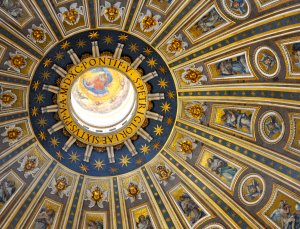Blog
Fifty years after Vatican II, Catholics are still hoping for a new vision
11 October 2012
Originally published in The Sydney Morning Herald

Catholicism today is incomprehensible without some knowledge of the Second Vatican Ecumenical or General Council. It was the 21st such gathering of Catholicism’s leaders in the history of the Church. It opened fifty years ago today in Rome’s Saint Peter’s Basilica. The effect of Vatican II on the world’s Catholic population (nowadays 1.96 billion) has been tumultuous.
It was a genuinely worldwide gathering with between 2500-2800 bishops present from almost every country in the world. It met over four sessions between 1962 and 1965.
It had been called by Pope John XXIII who realized that Catholicism had become stultified, turned-in on itself and cut-off from the modern world. He wanted ‘to throw open the windows’ and was critical of ‘the prophets of doom, who are always forecasting disaster.’ He wanted the church to reach-out ‘fearlessly’ to the world. Vatican II theologian Yves Congar said the church was being challenged ‘by the world to rejoin it in order to speak validly of Jesus Christ.’
For four decades before 1962 Catholic scholars had been evolving a renewed approach to theology, the bible, worship, religious formation, spirituality and faith which during Vatican II gradually influenced the views of the majority of the bishops. They developed a vision of the church open to the contemporary world, ministering to its needs, speaking of faith and spirituality in terms that made sense to people and emphasizing the priority of peace, social justice and equity.
The real struggle was to ensure that Vatican II documents reflected these priorities. But this was not going to be easy. The ‘prophets of doom’ were entrenched at the highest levels of the church and they resisted this more open vision to the end.
Pope John died in June 1963. He was succeeded by Paul VI (1963-1978) who continued the Council and generally supported the thrust of the large majority of the bishops. But psychologically Paul was a hesitant man, a ditherer even. He was afraid of alienating reactionary bishops especially those from the Roman Curia, the Vatican bureaucracy. He feared that they would walk-out of the Council leading to schism.
The result was that key documents of Vatican II were compromises. For instance the document on the nature of the church first envisions the church as a community drawn together by God’s Spirit and built not on the hierarchy but the people. But then, almost as if the community model didn’t exist, the church is characterised as an authority-driven, clerical institution dominated by pope, bishops and the Vatican.
These models are not only mutually exclusive, they are corrosive. The same kind of disjunction can be found in other documents, particularly the one on the priesthood.
Nevertheless after Vatican II people warmly embraced the community model of church. An enormous amount of energy and generosity were poured out as Catholics internalised the notion of a church that was willing to face up to the world’s problems and that was committed to social justice, peace and the building of inclusive communities. Much was achieved as Catholics threw their support behind movements like civil rights in the US and the struggle for Aboriginal rights in Australia.
But the signs of reaction were already there, like Paul VI’s rejection of the advice of his own specialist committee on the question of contraception and his condemnation of the pill. Then in late-1978 along came John Paul II. His almost superstar papacy was in itself an implicit contradiction of Vatican II’s doctrine which emphasized the role of bishops as leaders in the both the local and world-wide church. The Synod of Bishops which had been established by the Council for bishops to speak directly to the pope was subsequently reduced to a mere papal rubber-stamp.
Slowly more and more bishops were appointed who lacked the drive and intelligence to make a stand against a seemingly omnipotent papacy and Roman Curia that interfered in every aspect of local church life. Progressive theologians were condemned. Calls for the abolition of celibacy and the ordination of women were ignored. At the local level people who had embraced the Vatican II vision were repulsed by clerics who lacked sympathy with the reforms of the Council. The result has been fifty years of crisis and the alienation of vast numbers of people from Catholicism.
What future does the church have? As the American nun said to John Paul II ‘You can’t put the toothpaste back in the tube’. The Vatican II vision is still ‘out there’. Catholics have grasped the possibility of the church as a local community based on Jesus’ message of love, co-operation, tolerance and service to others. Such communities offer an alternative to the corrosive individualism and the ‘I did it my way’ egoism that characterises much of modern culture.
The anniversary of this vision still gives many Catholics real hope for the future of their church.
Care to comment? .